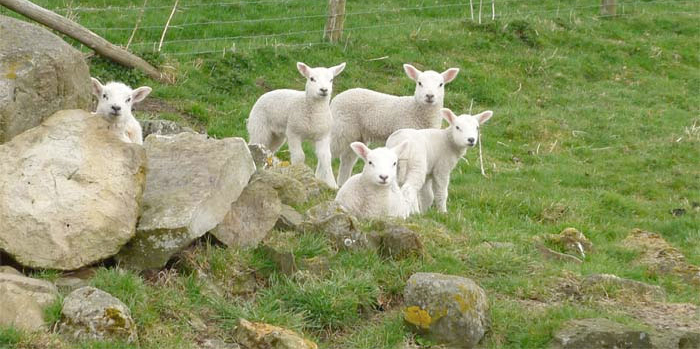
Cobalt deficiency in lambs was discussed at the recent Forth monitor farm meeting, hosted at Arnprior Farm near Stirling, by the McEwen family.
This spring the McEwens lambed almost 650 ewes, with lambing starting on 20th March.
Arnprior, an 815 acre (330 ha) unit, is one of the network of Quality Meat Scotland (QMS) monitor farms throughout Scotland. In addition to the sheep enterprise, Arnprior has a 60 head suckler herd and 200 acres (80 ha) of crops.
“Soil testing has shown that our soils are deficient in cobalt, selenium and copper,” Duncan McEwen junior told the community group. “So pre-tupping and pre-lambing, our ewes receive boluses which include all three trace elements.”
Cobalt is converted to Vitamin B12 in the rumen. A lack of Vitamin B12 suppresses appetite, resulting in what many farmers recognise as “pine” – a significant lack of growth, often with an open “starey” coat.
The cobalt requirement of lambs is low while they are suckling, but once they start grazing, their requirement greatly increases.
The McEwens’ 2015-born lambs performed well in their early months. “This year we drew lambs for slaughter earlier that we’ve done before and had 150 finished lambs away by 21st July,” remarked Mr McEwen. “Up until the Highland Show, all the lambs were thriving, with one group gaining 350 grammes per day on rotational grazing.”
The Arnprior lambs are electronically tagged and regularly weighed. A computerised, tag reading weigh cell provides instant individual live and daily weight gain information.
“We’re believers in regularly weighing lambs,” explained Mr McEwen. “It helps to ensure we’re drawing lambs when they’re ready and not being left to put on weight which will take them over abattoir spec.
“Regular weighing also alerts us to any drops in lamb performance, triggering an investigation to establish the cause.
“The first weighing after the Highland Show, it seemed as if they had hit a wall, some had even lost weight. We suspected cobalt deficiency and blood tested some of the most checked lambs. While their selenium levels were OK, their cobalt was on the floor.
“They rapidly improved after treatment with cobalt. In a way we were relieved that the blood test revealed such a definite explanation.”
In mid-July, the McEwens split 350 of their lambs into seven groups of 50, with an additional control group of ten lambs. All lambs were copper-bolused. Since then, each of the 50-lamb groups has either received a treatment of a cobalt drench or bolus. Assessment at the end of the season, to identify which group(s) performed the best, will give the McEwans an indication as to which cobalt treatment has been most effective.
“We need to prevent before the need to cure, and the aim of this year’s treatment comparison is to establish which is most suited to our farm,” explained Mr McEwen. “Just one week after receiving a cobalt treatment, there was a noticeable improvement in all the lambs. And with no withdrawal complications, by the end of July we had drawn almost a hundred further lambs for slaughter. If we hadn’t treated for cobalt deficiency, they would have continued to under-perform.”
Many of the farmers in the Forth community group reported that they had experienced a similar, sudden drop in lamb performance, with some voicing plans at the meeting to buy cobalt treatments the next day. In discussion, they were urged to take blood tests to establish the cause of the ill-thrift, before spending time and money .
The benefit of taking blood samples before testing was highlighted back in 2011, when the Moray and Nairn monitor farmer suspected either cobalt or selenium deficiency in his lambs. He was tempted to treat for trace elements, but before he did, he asked his vet to do blood and faecal tests. When the results came back, it relieved that the problem was not trace elements, but in fact liver fluke. To have treated blindly for trace elements would have been both a waste of time and money for that farmer.
